Employee Well-being: Initiatives and Organizational Examples
VerifiedAdded on 2023/01/13
|11
|3737
|68
Report
AI Summary
This report delves into the critical aspects of employee well-being, defining it as a strategic approach to manage and support employees for competitive advantage and profitability. It explores the nature, scope, and limitations of employee well-being, emphasizing the importance of mental and physical health, job satisfaction, and various wellness dimensions. The report highlights the significance of Duty of Care, a legal and moral obligation of employers. Furthermore, it provides a detailed case study of Unilever, a multinational company, and its initiatives to promote employee well-being through a four-pillar framework focusing on physical, mental, emotional, and purposeful well-being. The report analyzes how Unilever's strategies, including agile working, contribute to a supportive work environment and enhance employee engagement and retention, which is essential for achieving organizational goals.

Managing Human
Resources
Resources
Paraphrase This Document
Need a fresh take? Get an instant paraphrase of this document with our AI Paraphraser

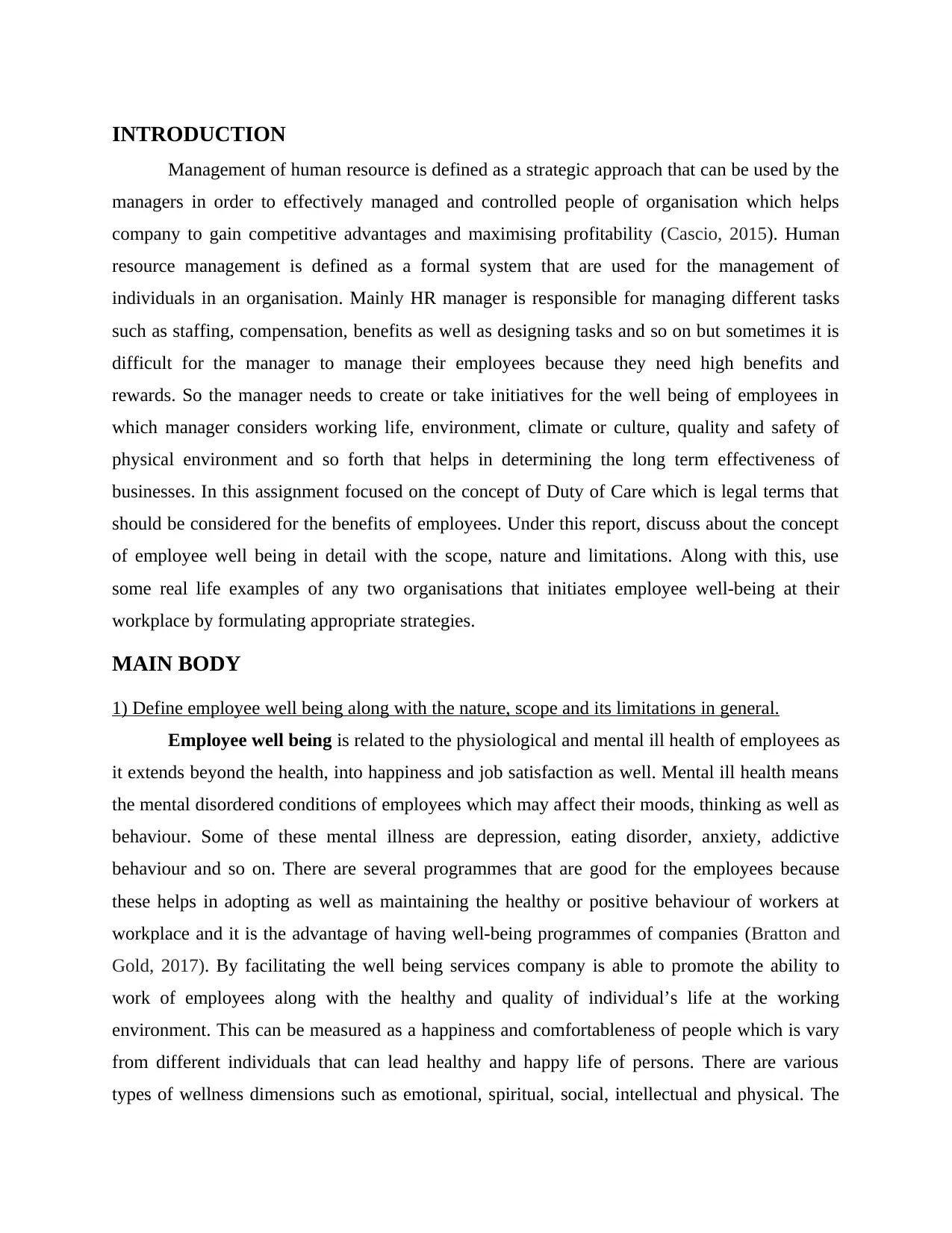
INTRODUCTION
Management of human resource is defined as a strategic approach that can be used by the
managers in order to effectively managed and controlled people of organisation which helps
company to gain competitive advantages and maximising profitability (Cascio, 2015). Human
resource management is defined as a formal system that are used for the management of
individuals in an organisation. Mainly HR manager is responsible for managing different tasks
such as staffing, compensation, benefits as well as designing tasks and so on but sometimes it is
difficult for the manager to manage their employees because they need high benefits and
rewards. So the manager needs to create or take initiatives for the well being of employees in
which manager considers working life, environment, climate or culture, quality and safety of
physical environment and so forth that helps in determining the long term effectiveness of
businesses. In this assignment focused on the concept of Duty of Care which is legal terms that
should be considered for the benefits of employees. Under this report, discuss about the concept
of employee well being in detail with the scope, nature and limitations. Along with this, use
some real life examples of any two organisations that initiates employee well-being at their
workplace by formulating appropriate strategies.
MAIN BODY
1) Define employee well being along with the nature, scope and its limitations in general.
Employee well being is related to the physiological and mental ill health of employees as
it extends beyond the health, into happiness and job satisfaction as well. Mental ill health means
the mental disordered conditions of employees which may affect their moods, thinking as well as
behaviour. Some of these mental illness are depression, eating disorder, anxiety, addictive
behaviour and so on. There are several programmes that are good for the employees because
these helps in adopting as well as maintaining the healthy or positive behaviour of workers at
workplace and it is the advantage of having well-being programmes of companies (Bratton and
Gold, 2017). By facilitating the well being services company is able to promote the ability to
work of employees along with the healthy and quality of individual’s life at the working
environment. This can be measured as a happiness and comfortableness of people which is vary
from different individuals that can lead healthy and happy life of persons. There are various
types of wellness dimensions such as emotional, spiritual, social, intellectual and physical. The
Management of human resource is defined as a strategic approach that can be used by the
managers in order to effectively managed and controlled people of organisation which helps
company to gain competitive advantages and maximising profitability (Cascio, 2015). Human
resource management is defined as a formal system that are used for the management of
individuals in an organisation. Mainly HR manager is responsible for managing different tasks
such as staffing, compensation, benefits as well as designing tasks and so on but sometimes it is
difficult for the manager to manage their employees because they need high benefits and
rewards. So the manager needs to create or take initiatives for the well being of employees in
which manager considers working life, environment, climate or culture, quality and safety of
physical environment and so forth that helps in determining the long term effectiveness of
businesses. In this assignment focused on the concept of Duty of Care which is legal terms that
should be considered for the benefits of employees. Under this report, discuss about the concept
of employee well being in detail with the scope, nature and limitations. Along with this, use
some real life examples of any two organisations that initiates employee well-being at their
workplace by formulating appropriate strategies.
MAIN BODY
1) Define employee well being along with the nature, scope and its limitations in general.
Employee well being is related to the physiological and mental ill health of employees as
it extends beyond the health, into happiness and job satisfaction as well. Mental ill health means
the mental disordered conditions of employees which may affect their moods, thinking as well as
behaviour. Some of these mental illness are depression, eating disorder, anxiety, addictive
behaviour and so on. There are several programmes that are good for the employees because
these helps in adopting as well as maintaining the healthy or positive behaviour of workers at
workplace and it is the advantage of having well-being programmes of companies (Bratton and
Gold, 2017). By facilitating the well being services company is able to promote the ability to
work of employees along with the healthy and quality of individual’s life at the working
environment. This can be measured as a happiness and comfortableness of people which is vary
from different individuals that can lead healthy and happy life of persons. There are various
types of wellness dimensions such as emotional, spiritual, social, intellectual and physical. The
⊘ This is a preview!⊘
Do you want full access?
Subscribe today to unlock all pages.

Trusted by 1+ million students worldwide
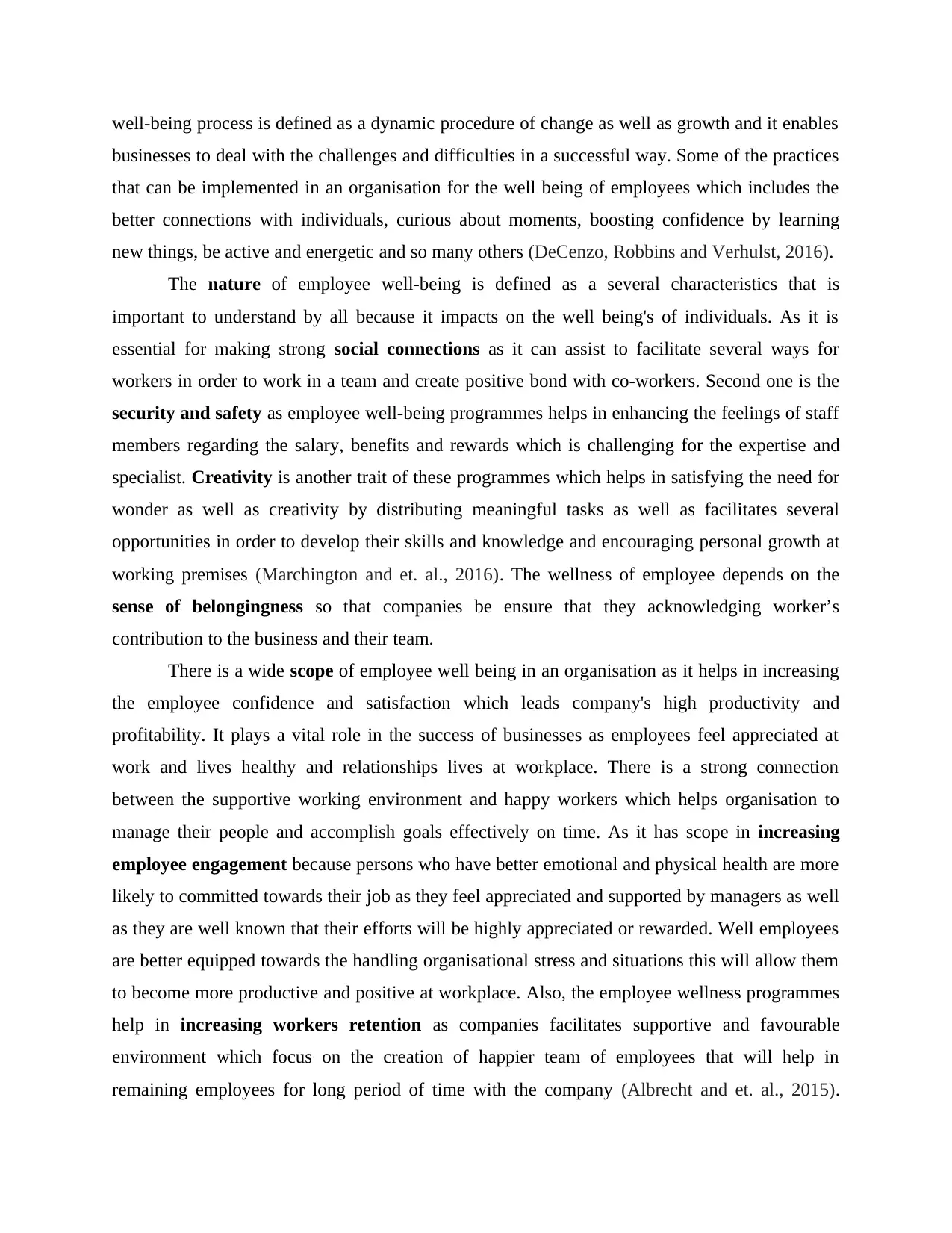
well-being process is defined as a dynamic procedure of change as well as growth and it enables
businesses to deal with the challenges and difficulties in a successful way. Some of the practices
that can be implemented in an organisation for the well being of employees which includes the
better connections with individuals, curious about moments, boosting confidence by learning
new things, be active and energetic and so many others (DeCenzo, Robbins and Verhulst, 2016).
The nature of employee well-being is defined as a several characteristics that is
important to understand by all because it impacts on the well being's of individuals. As it is
essential for making strong social connections as it can assist to facilitate several ways for
workers in order to work in a team and create positive bond with co-workers. Second one is the
security and safety as employee well-being programmes helps in enhancing the feelings of staff
members regarding the salary, benefits and rewards which is challenging for the expertise and
specialist. Creativity is another trait of these programmes which helps in satisfying the need for
wonder as well as creativity by distributing meaningful tasks as well as facilitates several
opportunities in order to develop their skills and knowledge and encouraging personal growth at
working premises (Marchington and et. al., 2016). The wellness of employee depends on the
sense of belongingness so that companies be ensure that they acknowledging worker’s
contribution to the business and their team.
There is a wide scope of employee well being in an organisation as it helps in increasing
the employee confidence and satisfaction which leads company's high productivity and
profitability. It plays a vital role in the success of businesses as employees feel appreciated at
work and lives healthy and relationships lives at workplace. There is a strong connection
between the supportive working environment and happy workers which helps organisation to
manage their people and accomplish goals effectively on time. As it has scope in increasing
employee engagement because persons who have better emotional and physical health are more
likely to committed towards their job as they feel appreciated and supported by managers as well
as they are well known that their efforts will be highly appreciated or rewarded. Well employees
are better equipped towards the handling organisational stress and situations this will allow them
to become more productive and positive at workplace. Also, the employee wellness programmes
help in increasing workers retention as companies facilitates supportive and favourable
environment which focus on the creation of happier team of employees that will help in
remaining employees for long period of time with the company (Albrecht and et. al., 2015).
businesses to deal with the challenges and difficulties in a successful way. Some of the practices
that can be implemented in an organisation for the well being of employees which includes the
better connections with individuals, curious about moments, boosting confidence by learning
new things, be active and energetic and so many others (DeCenzo, Robbins and Verhulst, 2016).
The nature of employee well-being is defined as a several characteristics that is
important to understand by all because it impacts on the well being's of individuals. As it is
essential for making strong social connections as it can assist to facilitate several ways for
workers in order to work in a team and create positive bond with co-workers. Second one is the
security and safety as employee well-being programmes helps in enhancing the feelings of staff
members regarding the salary, benefits and rewards which is challenging for the expertise and
specialist. Creativity is another trait of these programmes which helps in satisfying the need for
wonder as well as creativity by distributing meaningful tasks as well as facilitates several
opportunities in order to develop their skills and knowledge and encouraging personal growth at
working premises (Marchington and et. al., 2016). The wellness of employee depends on the
sense of belongingness so that companies be ensure that they acknowledging worker’s
contribution to the business and their team.
There is a wide scope of employee well being in an organisation as it helps in increasing
the employee confidence and satisfaction which leads company's high productivity and
profitability. It plays a vital role in the success of businesses as employees feel appreciated at
work and lives healthy and relationships lives at workplace. There is a strong connection
between the supportive working environment and happy workers which helps organisation to
manage their people and accomplish goals effectively on time. As it has scope in increasing
employee engagement because persons who have better emotional and physical health are more
likely to committed towards their job as they feel appreciated and supported by managers as well
as they are well known that their efforts will be highly appreciated or rewarded. Well employees
are better equipped towards the handling organisational stress and situations this will allow them
to become more productive and positive at workplace. Also, the employee wellness programmes
help in increasing workers retention as companies facilitates supportive and favourable
environment which focus on the creation of happier team of employees that will help in
remaining employees for long period of time with the company (Albrecht and et. al., 2015).
Paraphrase This Document
Need a fresh take? Get an instant paraphrase of this document with our AI Paraphraser

Through the application of wellness programmes at workplace employees feel that their manager
or employers truly care about them which makes them loyal and retain for longer duration in a
company. In addition, this is essential for the overall personal development as by organising
several wellness programmes the manager of company is able to develop individuals personally
which directly lead professional as well as career development of people. Also, it helps in
raising the company's productivity because initiatives of worker’s wellness lead better
relationship and healthy environment at workplace that is essential for encouraging staff
members in order to perform tasks and achieve organisational goals (Morgeson, Brannick and
Levine, 2019). If employees feel confident and trust on businesses, then they contribute more
which results in the increasing productivity of company.
Moreover, the employee well being programmes are not beneficial for the people or can
say that the limitations of this programmes do exist that is to be required identified before the
implementation of wellness strategies and programs. As this is costly to create at workplace
which cannot be easily affordable by people. As companies requires to offer perks and benefits
to their employees that will need to be cover the entire cost of all business activities. For
instance, a manager of company hire experts or specialist in order to aware employees and
motivated by their experience or thoughts so that company will pay to expertise for their time
and experience which is considered as a cost money (Key Disadvantages of Employee Wellness
Programs, 2019). As more features puts into wellness programmes then it becomes more
expensive. Sometimes, it invades privacy means workers are afraid to take participation in these
programmes with a fear of that others will find things out which they wanted to keep private.
There is the possibility that information may be shared with people other than employees. So that
the less participation of employees is not going to find success by these programs. The well
being programmes are not fit for everyone as company have those employees who already
motivated and confident which may not interested to attain wellness programmes. But company
offer incentives as well as perks benefits which may be unfair for already confident employees
that will leave them feeling of unhappy.
There is also a legal consideration of “Duty of Care” which means that it is considered
as legal form for businesses in order to put reasonable measures to make sure that all individuals
are associated with it is fully secured and protected towards the psychological as well as physical
harms. Both employer and employees have responsibility towards each other which should be
or employers truly care about them which makes them loyal and retain for longer duration in a
company. In addition, this is essential for the overall personal development as by organising
several wellness programmes the manager of company is able to develop individuals personally
which directly lead professional as well as career development of people. Also, it helps in
raising the company's productivity because initiatives of worker’s wellness lead better
relationship and healthy environment at workplace that is essential for encouraging staff
members in order to perform tasks and achieve organisational goals (Morgeson, Brannick and
Levine, 2019). If employees feel confident and trust on businesses, then they contribute more
which results in the increasing productivity of company.
Moreover, the employee well being programmes are not beneficial for the people or can
say that the limitations of this programmes do exist that is to be required identified before the
implementation of wellness strategies and programs. As this is costly to create at workplace
which cannot be easily affordable by people. As companies requires to offer perks and benefits
to their employees that will need to be cover the entire cost of all business activities. For
instance, a manager of company hire experts or specialist in order to aware employees and
motivated by their experience or thoughts so that company will pay to expertise for their time
and experience which is considered as a cost money (Key Disadvantages of Employee Wellness
Programs, 2019). As more features puts into wellness programmes then it becomes more
expensive. Sometimes, it invades privacy means workers are afraid to take participation in these
programmes with a fear of that others will find things out which they wanted to keep private.
There is the possibility that information may be shared with people other than employees. So that
the less participation of employees is not going to find success by these programs. The well
being programmes are not fit for everyone as company have those employees who already
motivated and confident which may not interested to attain wellness programmes. But company
offer incentives as well as perks benefits which may be unfair for already confident employees
that will leave them feeling of unhappy.
There is also a legal consideration of “Duty of Care” which means that it is considered
as legal form for businesses in order to put reasonable measures to make sure that all individuals
are associated with it is fully secured and protected towards the psychological as well as physical
harms. Both employer and employees have responsibility towards each other which should be
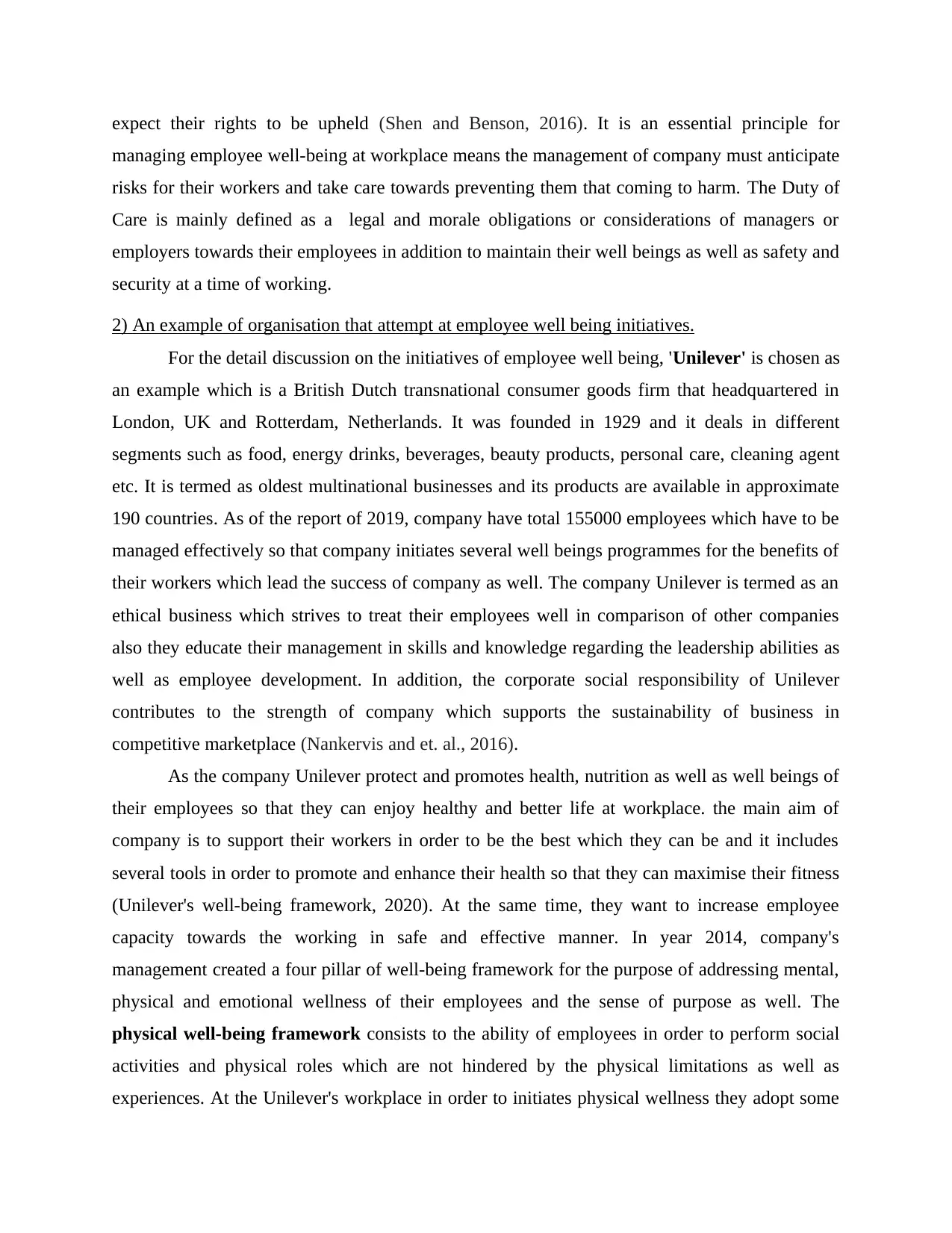
expect their rights to be upheld (Shen and Benson, 2016). It is an essential principle for
managing employee well-being at workplace means the management of company must anticipate
risks for their workers and take care towards preventing them that coming to harm. The Duty of
Care is mainly defined as a legal and morale obligations or considerations of managers or
employers towards their employees in addition to maintain their well beings as well as safety and
security at a time of working.
2) An example of organisation that attempt at employee well being initiatives.
For the detail discussion on the initiatives of employee well being, 'Unilever' is chosen as
an example which is a British Dutch transnational consumer goods firm that headquartered in
London, UK and Rotterdam, Netherlands. It was founded in 1929 and it deals in different
segments such as food, energy drinks, beverages, beauty products, personal care, cleaning agent
etc. It is termed as oldest multinational businesses and its products are available in approximate
190 countries. As of the report of 2019, company have total 155000 employees which have to be
managed effectively so that company initiates several well beings programmes for the benefits of
their workers which lead the success of company as well. The company Unilever is termed as an
ethical business which strives to treat their employees well in comparison of other companies
also they educate their management in skills and knowledge regarding the leadership abilities as
well as employee development. In addition, the corporate social responsibility of Unilever
contributes to the strength of company which supports the sustainability of business in
competitive marketplace (Nankervis and et. al., 2016).
As the company Unilever protect and promotes health, nutrition as well as well beings of
their employees so that they can enjoy healthy and better life at workplace. the main aim of
company is to support their workers in order to be the best which they can be and it includes
several tools in order to promote and enhance their health so that they can maximise their fitness
(Unilever's well-being framework, 2020). At the same time, they want to increase employee
capacity towards the working in safe and effective manner. In year 2014, company's
management created a four pillar of well-being framework for the purpose of addressing mental,
physical and emotional wellness of their employees and the sense of purpose as well. The
physical well-being framework consists to the ability of employees in order to perform social
activities and physical roles which are not hindered by the physical limitations as well as
experiences. At the Unilever's workplace in order to initiates physical wellness they adopt some
managing employee well-being at workplace means the management of company must anticipate
risks for their workers and take care towards preventing them that coming to harm. The Duty of
Care is mainly defined as a legal and morale obligations or considerations of managers or
employers towards their employees in addition to maintain their well beings as well as safety and
security at a time of working.
2) An example of organisation that attempt at employee well being initiatives.
For the detail discussion on the initiatives of employee well being, 'Unilever' is chosen as
an example which is a British Dutch transnational consumer goods firm that headquartered in
London, UK and Rotterdam, Netherlands. It was founded in 1929 and it deals in different
segments such as food, energy drinks, beverages, beauty products, personal care, cleaning agent
etc. It is termed as oldest multinational businesses and its products are available in approximate
190 countries. As of the report of 2019, company have total 155000 employees which have to be
managed effectively so that company initiates several well beings programmes for the benefits of
their workers which lead the success of company as well. The company Unilever is termed as an
ethical business which strives to treat their employees well in comparison of other companies
also they educate their management in skills and knowledge regarding the leadership abilities as
well as employee development. In addition, the corporate social responsibility of Unilever
contributes to the strength of company which supports the sustainability of business in
competitive marketplace (Nankervis and et. al., 2016).
As the company Unilever protect and promotes health, nutrition as well as well beings of
their employees so that they can enjoy healthy and better life at workplace. the main aim of
company is to support their workers in order to be the best which they can be and it includes
several tools in order to promote and enhance their health so that they can maximise their fitness
(Unilever's well-being framework, 2020). At the same time, they want to increase employee
capacity towards the working in safe and effective manner. In year 2014, company's
management created a four pillar of well-being framework for the purpose of addressing mental,
physical and emotional wellness of their employees and the sense of purpose as well. The
physical well-being framework consists to the ability of employees in order to perform social
activities and physical roles which are not hindered by the physical limitations as well as
experiences. At the Unilever's workplace in order to initiates physical wellness they adopt some
⊘ This is a preview!⊘
Do you want full access?
Subscribe today to unlock all pages.

Trusted by 1+ million students worldwide
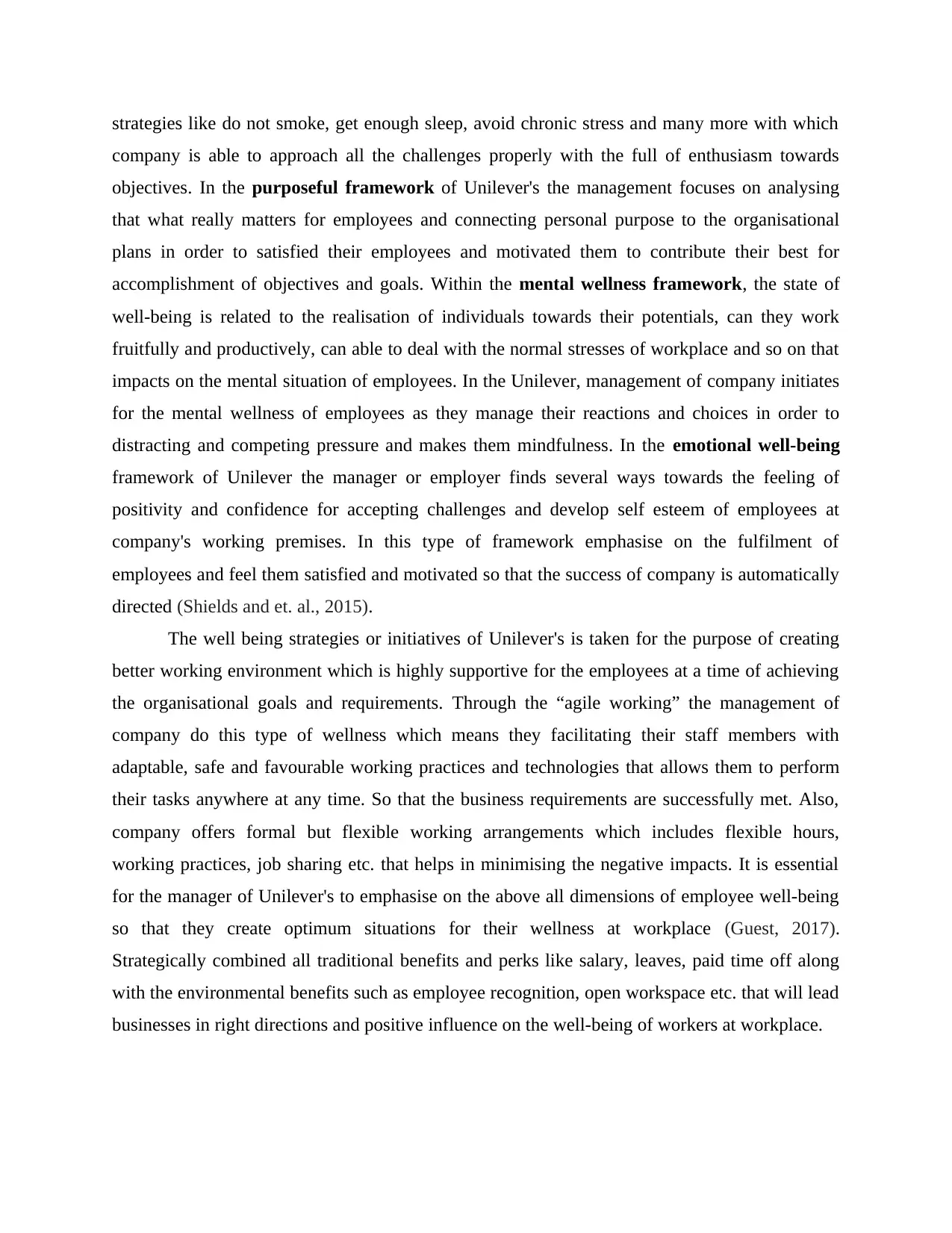
strategies like do not smoke, get enough sleep, avoid chronic stress and many more with which
company is able to approach all the challenges properly with the full of enthusiasm towards
objectives. In the purposeful framework of Unilever's the management focuses on analysing
that what really matters for employees and connecting personal purpose to the organisational
plans in order to satisfied their employees and motivated them to contribute their best for
accomplishment of objectives and goals. Within the mental wellness framework, the state of
well-being is related to the realisation of individuals towards their potentials, can they work
fruitfully and productively, can able to deal with the normal stresses of workplace and so on that
impacts on the mental situation of employees. In the Unilever, management of company initiates
for the mental wellness of employees as they manage their reactions and choices in order to
distracting and competing pressure and makes them mindfulness. In the emotional well-being
framework of Unilever the manager or employer finds several ways towards the feeling of
positivity and confidence for accepting challenges and develop self esteem of employees at
company's working premises. In this type of framework emphasise on the fulfilment of
employees and feel them satisfied and motivated so that the success of company is automatically
directed (Shields and et. al., 2015).
The well being strategies or initiatives of Unilever's is taken for the purpose of creating
better working environment which is highly supportive for the employees at a time of achieving
the organisational goals and requirements. Through the “agile working” the management of
company do this type of wellness which means they facilitating their staff members with
adaptable, safe and favourable working practices and technologies that allows them to perform
their tasks anywhere at any time. So that the business requirements are successfully met. Also,
company offers formal but flexible working arrangements which includes flexible hours,
working practices, job sharing etc. that helps in minimising the negative impacts. It is essential
for the manager of Unilever's to emphasise on the above all dimensions of employee well-being
so that they create optimum situations for their wellness at workplace (Guest, 2017).
Strategically combined all traditional benefits and perks like salary, leaves, paid time off along
with the environmental benefits such as employee recognition, open workspace etc. that will lead
businesses in right directions and positive influence on the well-being of workers at workplace.
company is able to approach all the challenges properly with the full of enthusiasm towards
objectives. In the purposeful framework of Unilever's the management focuses on analysing
that what really matters for employees and connecting personal purpose to the organisational
plans in order to satisfied their employees and motivated them to contribute their best for
accomplishment of objectives and goals. Within the mental wellness framework, the state of
well-being is related to the realisation of individuals towards their potentials, can they work
fruitfully and productively, can able to deal with the normal stresses of workplace and so on that
impacts on the mental situation of employees. In the Unilever, management of company initiates
for the mental wellness of employees as they manage their reactions and choices in order to
distracting and competing pressure and makes them mindfulness. In the emotional well-being
framework of Unilever the manager or employer finds several ways towards the feeling of
positivity and confidence for accepting challenges and develop self esteem of employees at
company's working premises. In this type of framework emphasise on the fulfilment of
employees and feel them satisfied and motivated so that the success of company is automatically
directed (Shields and et. al., 2015).
The well being strategies or initiatives of Unilever's is taken for the purpose of creating
better working environment which is highly supportive for the employees at a time of achieving
the organisational goals and requirements. Through the “agile working” the management of
company do this type of wellness which means they facilitating their staff members with
adaptable, safe and favourable working practices and technologies that allows them to perform
their tasks anywhere at any time. So that the business requirements are successfully met. Also,
company offers formal but flexible working arrangements which includes flexible hours,
working practices, job sharing etc. that helps in minimising the negative impacts. It is essential
for the manager of Unilever's to emphasise on the above all dimensions of employee well-being
so that they create optimum situations for their wellness at workplace (Guest, 2017).
Strategically combined all traditional benefits and perks like salary, leaves, paid time off along
with the environmental benefits such as employee recognition, open workspace etc. that will lead
businesses in right directions and positive influence on the well-being of workers at workplace.
Paraphrase This Document
Need a fresh take? Get an instant paraphrase of this document with our AI Paraphraser
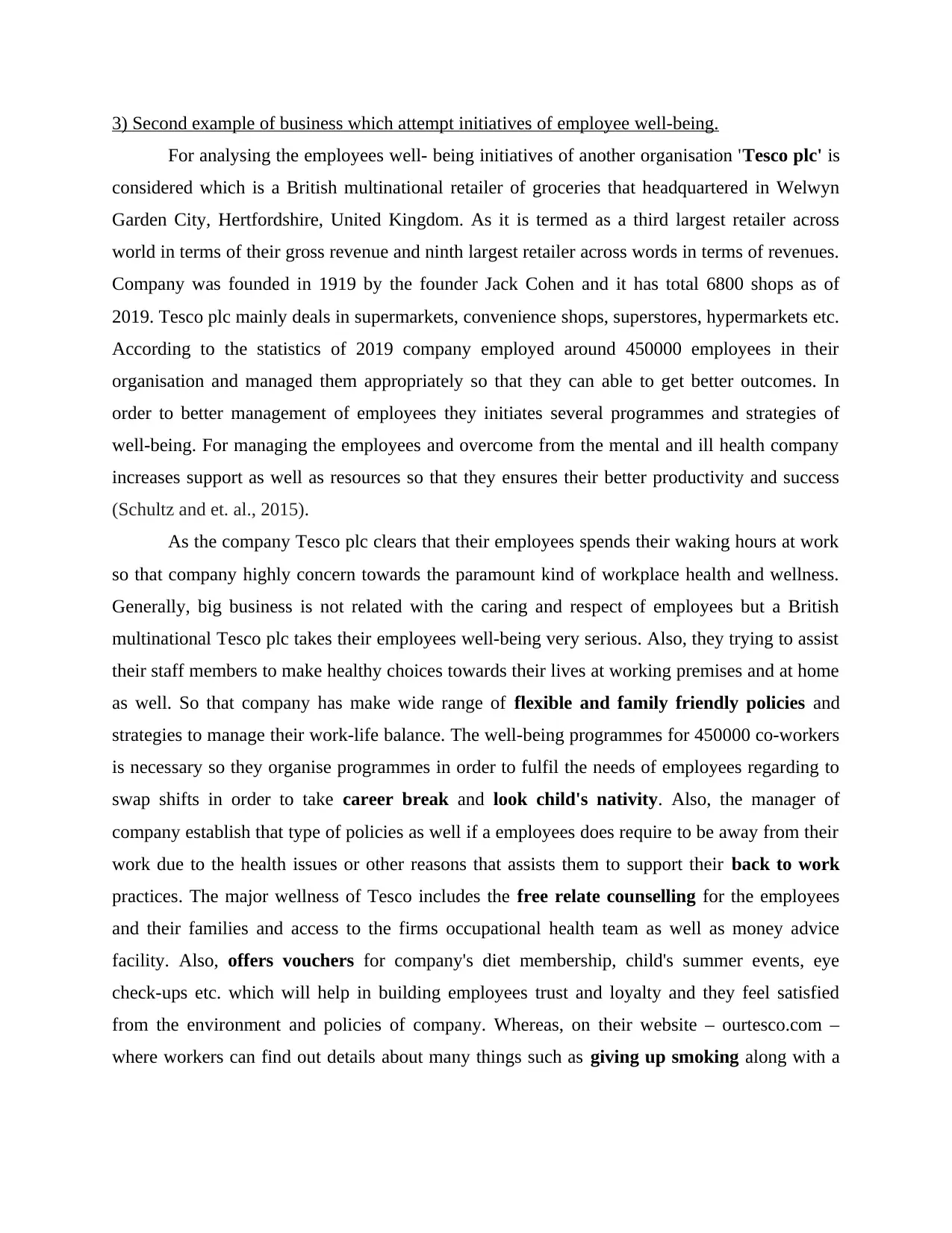
3) Second example of business which attempt initiatives of employee well-being.
For analysing the employees well- being initiatives of another organisation 'Tesco plc' is
considered which is a British multinational retailer of groceries that headquartered in Welwyn
Garden City, Hertfordshire, United Kingdom. As it is termed as a third largest retailer across
world in terms of their gross revenue and ninth largest retailer across words in terms of revenues.
Company was founded in 1919 by the founder Jack Cohen and it has total 6800 shops as of
2019. Tesco plc mainly deals in supermarkets, convenience shops, superstores, hypermarkets etc.
According to the statistics of 2019 company employed around 450000 employees in their
organisation and managed them appropriately so that they can able to get better outcomes. In
order to better management of employees they initiates several programmes and strategies of
well-being. For managing the employees and overcome from the mental and ill health company
increases support as well as resources so that they ensures their better productivity and success
(Schultz and et. al., 2015).
As the company Tesco plc clears that their employees spends their waking hours at work
so that company highly concern towards the paramount kind of workplace health and wellness.
Generally, big business is not related with the caring and respect of employees but a British
multinational Tesco plc takes their employees well-being very serious. Also, they trying to assist
their staff members to make healthy choices towards their lives at working premises and at home
as well. So that company has make wide range of flexible and family friendly policies and
strategies to manage their work-life balance. The well-being programmes for 450000 co-workers
is necessary so they organise programmes in order to fulfil the needs of employees regarding to
swap shifts in order to take career break and look child's nativity. Also, the manager of
company establish that type of policies as well if a employees does require to be away from their
work due to the health issues or other reasons that assists them to support their back to work
practices. The major wellness of Tesco includes the free relate counselling for the employees
and their families and access to the firms occupational health team as well as money advice
facility. Also, offers vouchers for company's diet membership, child's summer events, eye
check-ups etc. which will help in building employees trust and loyalty and they feel satisfied
from the environment and policies of company. Whereas, on their website – ourtesco.com –
where workers can find out details about many things such as giving up smoking along with a
For analysing the employees well- being initiatives of another organisation 'Tesco plc' is
considered which is a British multinational retailer of groceries that headquartered in Welwyn
Garden City, Hertfordshire, United Kingdom. As it is termed as a third largest retailer across
world in terms of their gross revenue and ninth largest retailer across words in terms of revenues.
Company was founded in 1919 by the founder Jack Cohen and it has total 6800 shops as of
2019. Tesco plc mainly deals in supermarkets, convenience shops, superstores, hypermarkets etc.
According to the statistics of 2019 company employed around 450000 employees in their
organisation and managed them appropriately so that they can able to get better outcomes. In
order to better management of employees they initiates several programmes and strategies of
well-being. For managing the employees and overcome from the mental and ill health company
increases support as well as resources so that they ensures their better productivity and success
(Schultz and et. al., 2015).
As the company Tesco plc clears that their employees spends their waking hours at work
so that company highly concern towards the paramount kind of workplace health and wellness.
Generally, big business is not related with the caring and respect of employees but a British
multinational Tesco plc takes their employees well-being very serious. Also, they trying to assist
their staff members to make healthy choices towards their lives at working premises and at home
as well. So that company has make wide range of flexible and family friendly policies and
strategies to manage their work-life balance. The well-being programmes for 450000 co-workers
is necessary so they organise programmes in order to fulfil the needs of employees regarding to
swap shifts in order to take career break and look child's nativity. Also, the manager of
company establish that type of policies as well if a employees does require to be away from their
work due to the health issues or other reasons that assists them to support their back to work
practices. The major wellness of Tesco includes the free relate counselling for the employees
and their families and access to the firms occupational health team as well as money advice
facility. Also, offers vouchers for company's diet membership, child's summer events, eye
check-ups etc. which will help in building employees trust and loyalty and they feel satisfied
from the environment and policies of company. Whereas, on their website – ourtesco.com –
where workers can find out details about many things such as giving up smoking along with a
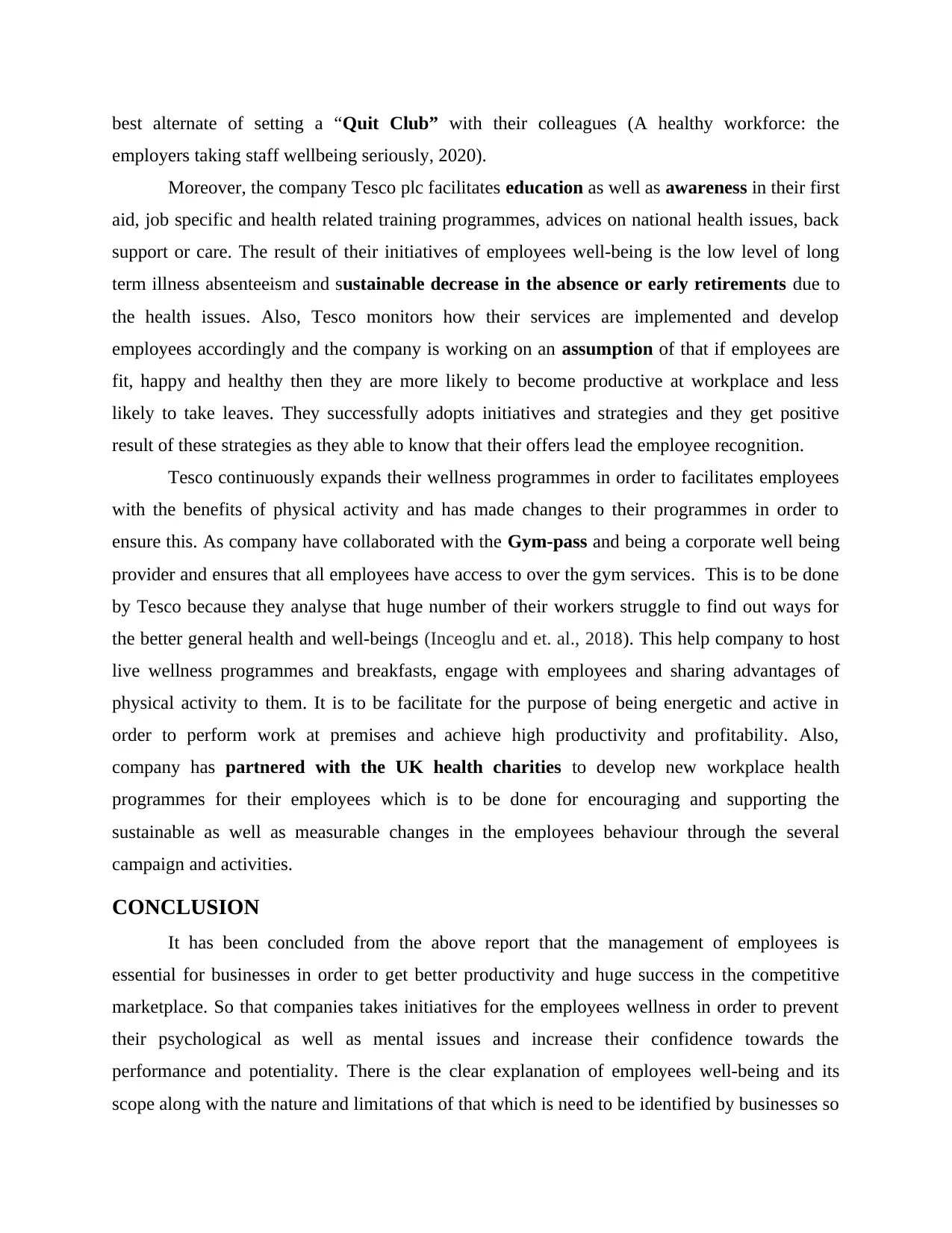
best alternate of setting a “Quit Club” with their colleagues (A healthy workforce: the
employers taking staff wellbeing seriously, 2020).
Moreover, the company Tesco plc facilitates education as well as awareness in their first
aid, job specific and health related training programmes, advices on national health issues, back
support or care. The result of their initiatives of employees well-being is the low level of long
term illness absenteeism and sustainable decrease in the absence or early retirements due to
the health issues. Also, Tesco monitors how their services are implemented and develop
employees accordingly and the company is working on an assumption of that if employees are
fit, happy and healthy then they are more likely to become productive at workplace and less
likely to take leaves. They successfully adopts initiatives and strategies and they get positive
result of these strategies as they able to know that their offers lead the employee recognition.
Tesco continuously expands their wellness programmes in order to facilitates employees
with the benefits of physical activity and has made changes to their programmes in order to
ensure this. As company have collaborated with the Gym-pass and being a corporate well being
provider and ensures that all employees have access to over the gym services. This is to be done
by Tesco because they analyse that huge number of their workers struggle to find out ways for
the better general health and well-beings (Inceoglu and et. al., 2018). This help company to host
live wellness programmes and breakfasts, engage with employees and sharing advantages of
physical activity to them. It is to be facilitate for the purpose of being energetic and active in
order to perform work at premises and achieve high productivity and profitability. Also,
company has partnered with the UK health charities to develop new workplace health
programmes for their employees which is to be done for encouraging and supporting the
sustainable as well as measurable changes in the employees behaviour through the several
campaign and activities.
CONCLUSION
It has been concluded from the above report that the management of employees is
essential for businesses in order to get better productivity and huge success in the competitive
marketplace. So that companies takes initiatives for the employees wellness in order to prevent
their psychological as well as mental issues and increase their confidence towards the
performance and potentiality. There is the clear explanation of employees well-being and its
scope along with the nature and limitations of that which is need to be identified by businesses so
employers taking staff wellbeing seriously, 2020).
Moreover, the company Tesco plc facilitates education as well as awareness in their first
aid, job specific and health related training programmes, advices on national health issues, back
support or care. The result of their initiatives of employees well-being is the low level of long
term illness absenteeism and sustainable decrease in the absence or early retirements due to
the health issues. Also, Tesco monitors how their services are implemented and develop
employees accordingly and the company is working on an assumption of that if employees are
fit, happy and healthy then they are more likely to become productive at workplace and less
likely to take leaves. They successfully adopts initiatives and strategies and they get positive
result of these strategies as they able to know that their offers lead the employee recognition.
Tesco continuously expands their wellness programmes in order to facilitates employees
with the benefits of physical activity and has made changes to their programmes in order to
ensure this. As company have collaborated with the Gym-pass and being a corporate well being
provider and ensures that all employees have access to over the gym services. This is to be done
by Tesco because they analyse that huge number of their workers struggle to find out ways for
the better general health and well-beings (Inceoglu and et. al., 2018). This help company to host
live wellness programmes and breakfasts, engage with employees and sharing advantages of
physical activity to them. It is to be facilitate for the purpose of being energetic and active in
order to perform work at premises and achieve high productivity and profitability. Also,
company has partnered with the UK health charities to develop new workplace health
programmes for their employees which is to be done for encouraging and supporting the
sustainable as well as measurable changes in the employees behaviour through the several
campaign and activities.
CONCLUSION
It has been concluded from the above report that the management of employees is
essential for businesses in order to get better productivity and huge success in the competitive
marketplace. So that companies takes initiatives for the employees wellness in order to prevent
their psychological as well as mental issues and increase their confidence towards the
performance and potentiality. There is the clear explanation of employees well-being and its
scope along with the nature and limitations of that which is need to be identified by businesses so
⊘ This is a preview!⊘
Do you want full access?
Subscribe today to unlock all pages.

Trusted by 1+ million students worldwide
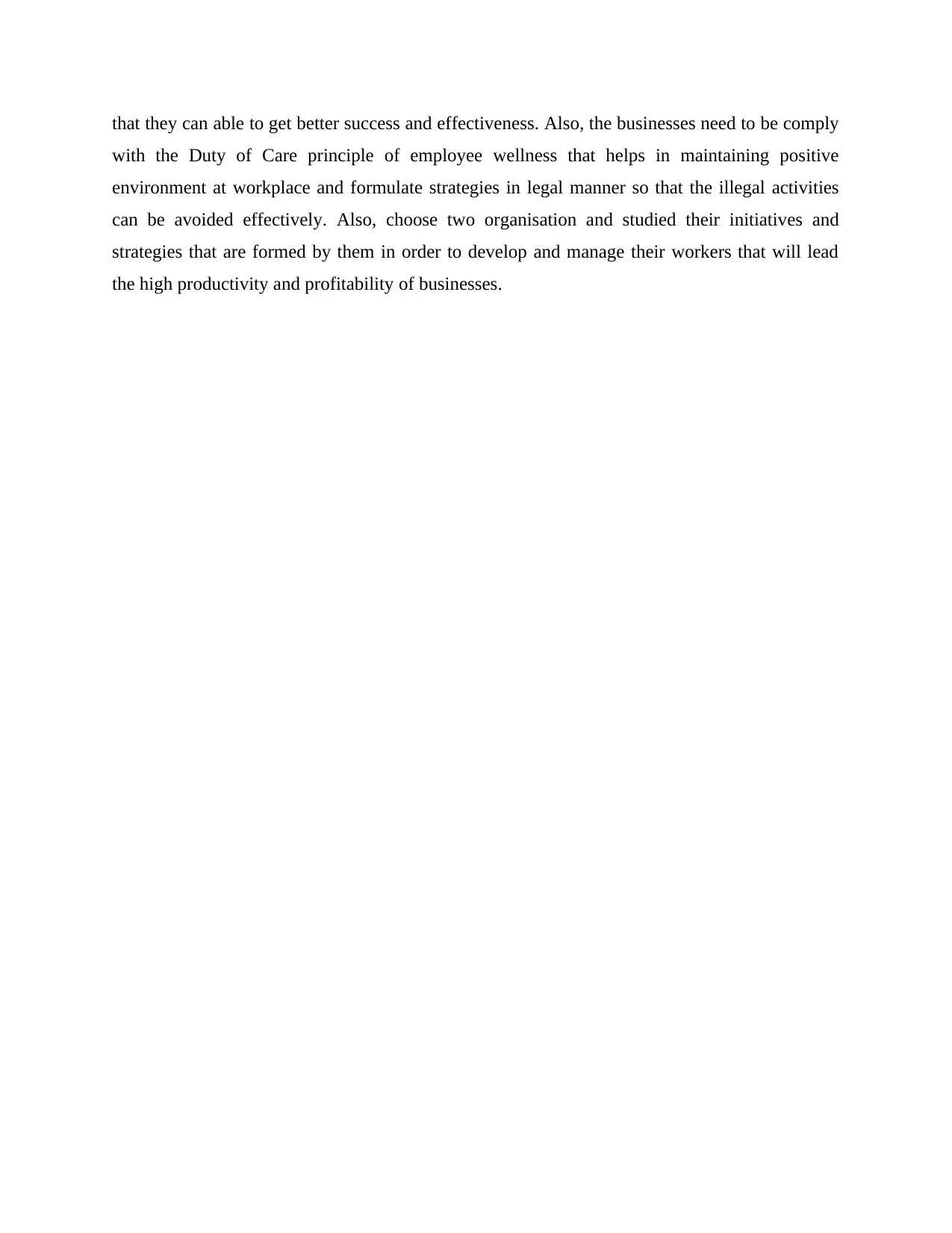
that they can able to get better success and effectiveness. Also, the businesses need to be comply
with the Duty of Care principle of employee wellness that helps in maintaining positive
environment at workplace and formulate strategies in legal manner so that the illegal activities
can be avoided effectively. Also, choose two organisation and studied their initiatives and
strategies that are formed by them in order to develop and manage their workers that will lead
the high productivity and profitability of businesses.
with the Duty of Care principle of employee wellness that helps in maintaining positive
environment at workplace and formulate strategies in legal manner so that the illegal activities
can be avoided effectively. Also, choose two organisation and studied their initiatives and
strategies that are formed by them in order to develop and manage their workers that will lead
the high productivity and profitability of businesses.
Paraphrase This Document
Need a fresh take? Get an instant paraphrase of this document with our AI Paraphraser
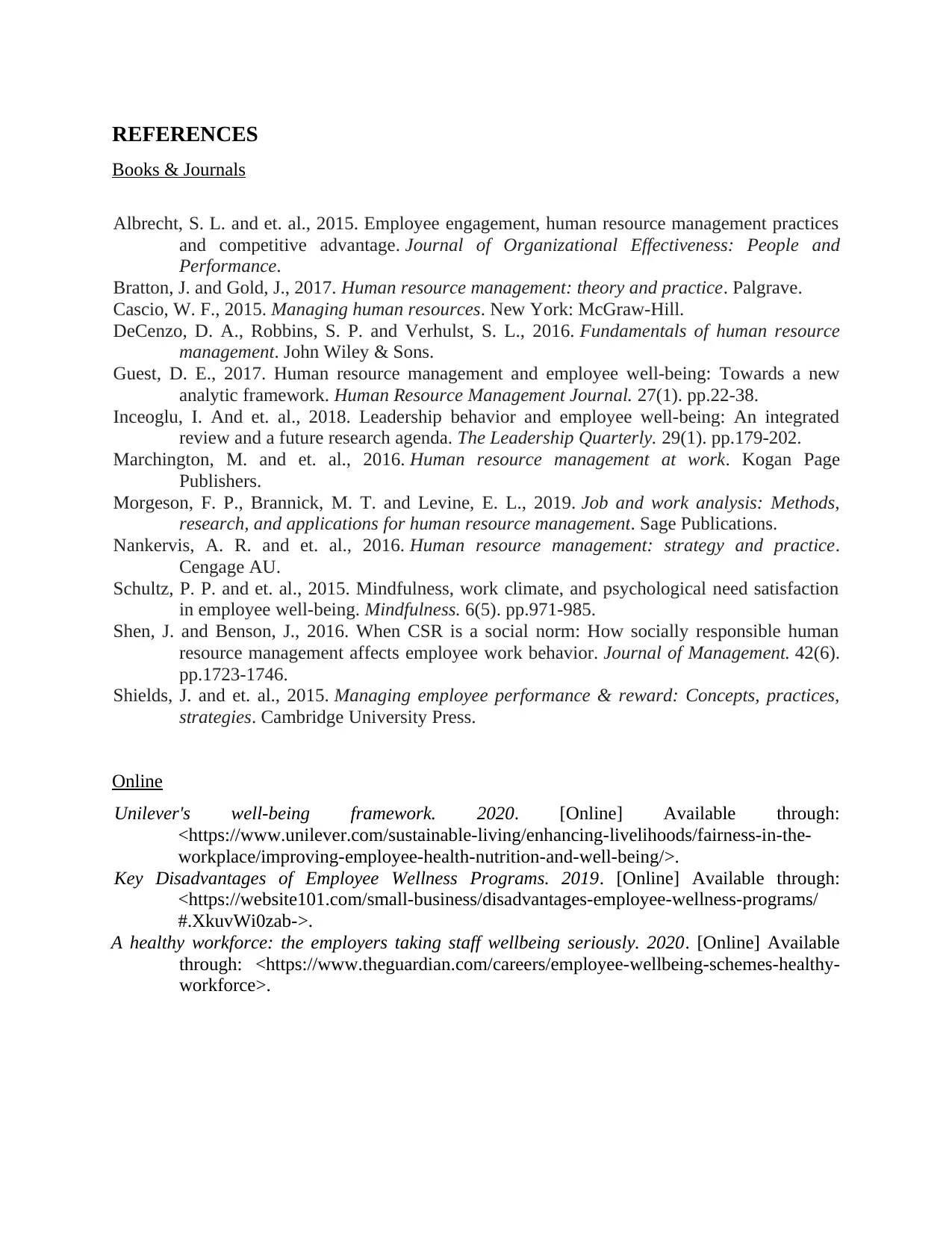
REFERENCES
Books & Journals
Albrecht, S. L. and et. al., 2015. Employee engagement, human resource management practices
and competitive advantage. Journal of Organizational Effectiveness: People and
Performance.
Bratton, J. and Gold, J., 2017. Human resource management: theory and practice. Palgrave.
Cascio, W. F., 2015. Managing human resources. New York: McGraw-Hill.
DeCenzo, D. A., Robbins, S. P. and Verhulst, S. L., 2016. Fundamentals of human resource
management. John Wiley & Sons.
Guest, D. E., 2017. Human resource management and employee well‐being: Towards a new
analytic framework. Human Resource Management Journal. 27(1). pp.22-38.
Inceoglu, I. And et. al., 2018. Leadership behavior and employee well-being: An integrated
review and a future research agenda. The Leadership Quarterly. 29(1). pp.179-202.
Marchington, M. and et. al., 2016. Human resource management at work. Kogan Page
Publishers.
Morgeson, F. P., Brannick, M. T. and Levine, E. L., 2019. Job and work analysis: Methods,
research, and applications for human resource management. Sage Publications.
Nankervis, A. R. and et. al., 2016. Human resource management: strategy and practice.
Cengage AU.
Schultz, P. P. and et. al., 2015. Mindfulness, work climate, and psychological need satisfaction
in employee well-being. Mindfulness. 6(5). pp.971-985.
Shen, J. and Benson, J., 2016. When CSR is a social norm: How socially responsible human
resource management affects employee work behavior. Journal of Management. 42(6).
pp.1723-1746.
Shields, J. and et. al., 2015. Managing employee performance & reward: Concepts, practices,
strategies. Cambridge University Press.
Online
Unilever's well-being framework. 2020. [Online] Available through:
<https://www.unilever.com/sustainable-living/enhancing-livelihoods/fairness-in-the-
workplace/improving-employee-health-nutrition-and-well-being/>.
Key Disadvantages of Employee Wellness Programs. 2019. [Online] Available through:
<https://website101.com/small-business/disadvantages-employee-wellness-programs/
#.XkuvWi0zab->.
A healthy workforce: the employers taking staff wellbeing seriously. 2020. [Online] Available
through: <https://www.theguardian.com/careers/employee-wellbeing-schemes-healthy-
workforce>.
Books & Journals
Albrecht, S. L. and et. al., 2015. Employee engagement, human resource management practices
and competitive advantage. Journal of Organizational Effectiveness: People and
Performance.
Bratton, J. and Gold, J., 2017. Human resource management: theory and practice. Palgrave.
Cascio, W. F., 2015. Managing human resources. New York: McGraw-Hill.
DeCenzo, D. A., Robbins, S. P. and Verhulst, S. L., 2016. Fundamentals of human resource
management. John Wiley & Sons.
Guest, D. E., 2017. Human resource management and employee well‐being: Towards a new
analytic framework. Human Resource Management Journal. 27(1). pp.22-38.
Inceoglu, I. And et. al., 2018. Leadership behavior and employee well-being: An integrated
review and a future research agenda. The Leadership Quarterly. 29(1). pp.179-202.
Marchington, M. and et. al., 2016. Human resource management at work. Kogan Page
Publishers.
Morgeson, F. P., Brannick, M. T. and Levine, E. L., 2019. Job and work analysis: Methods,
research, and applications for human resource management. Sage Publications.
Nankervis, A. R. and et. al., 2016. Human resource management: strategy and practice.
Cengage AU.
Schultz, P. P. and et. al., 2015. Mindfulness, work climate, and psychological need satisfaction
in employee well-being. Mindfulness. 6(5). pp.971-985.
Shen, J. and Benson, J., 2016. When CSR is a social norm: How socially responsible human
resource management affects employee work behavior. Journal of Management. 42(6).
pp.1723-1746.
Shields, J. and et. al., 2015. Managing employee performance & reward: Concepts, practices,
strategies. Cambridge University Press.
Online
Unilever's well-being framework. 2020. [Online] Available through:
<https://www.unilever.com/sustainable-living/enhancing-livelihoods/fairness-in-the-
workplace/improving-employee-health-nutrition-and-well-being/>.
Key Disadvantages of Employee Wellness Programs. 2019. [Online] Available through:
<https://website101.com/small-business/disadvantages-employee-wellness-programs/
#.XkuvWi0zab->.
A healthy workforce: the employers taking staff wellbeing seriously. 2020. [Online] Available
through: <https://www.theguardian.com/careers/employee-wellbeing-schemes-healthy-
workforce>.
1 out of 11
Related Documents
Your All-in-One AI-Powered Toolkit for Academic Success.
+13062052269
info@desklib.com
Available 24*7 on WhatsApp / Email
![[object Object]](/_next/static/media/star-bottom.7253800d.svg)
Unlock your academic potential
Copyright © 2020–2025 A2Z Services. All Rights Reserved. Developed and managed by ZUCOL.





